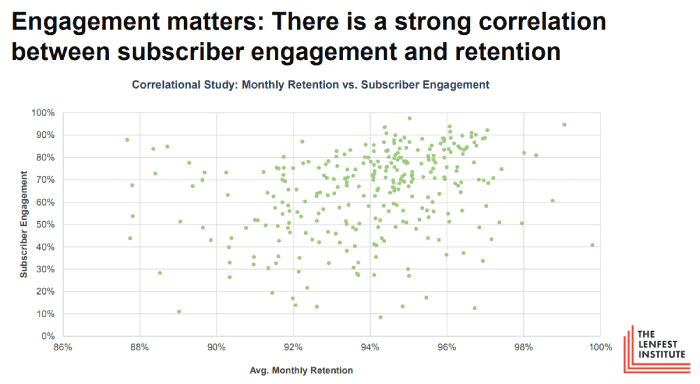It doesn’t take a team of data scientists to see the success of email newsletters.
If the ever-increasing abundance of publisher and personal newsletters is any indication, email certainly seems to be paying off. But, as that team of data scientists might ask, what do the numbers say?
Well, they seem to agree.
Here are a few email newsletter statistics from across the publishing & media sphere that show just how effective email can be for engaging your audience, converting paid subscribers, and retaining readers.
Newsletters create engaged audiences.
As a direct way to connect readers with content, it’s no wonder that publishers tend to earn more engagement from email than other channels.
1) According to industry benchmarks, publisher newsletters earn an open rate of 22%. That means 22% of your email audience will see your content, compared to a fraction of that percentage for your Facebook audience. You may see even higher open rates; the Washington Post’s newsletters average a 30% open rate, while PostUp client 1440 Media routinely earns a 50+% open rate.
2) Greentech Media’s newsletter visitors spend 80% more time on site than visitors from other channels. (Parse.ly, 2018) More time spent on your site means more page views, more ad impressions, and more revenue.
3) Vox’s newsletter readers spend an average of 110 seconds on the site, compared to just 40 seconds for Facebook visitors. (Really Good Emails, 2018) Social media audiences tend to skim content absent-mindedly. To create truly engaged audiences, you need to get their full attention in an environment you control—email.
4) Vanity Fair’s newsletter readers consume 2X more content than any other audience segment. (Digiday, October 2017) Their automated email program sends personalized news alerts to alert readers when a celebrity they follow is in the news, and it pays off.
5) PostUp clients see twice as many pageviews per session from email than any other channel. (PostUp) Publishers like Vox and Vanity Fair aren’t outliers. As we’ve seen across our clients, a solid email program leads to solid audience relationships.
Newsletters lead to paid subscriptions.
While the ideal premium business model looks a bit different for every publisher, one thing’s for sure: the road to paid subscriptions is paved with newsletters. Here are a few examples:
6) New York Times visitors are 2X more likely to become paid subscribers if they subscribe to a newsletter first. (New York Times, 2017) While name recognition and global reputation undoubtedly plays a role in the NYT’s unparalleled digital success, having a strong email program certainly doesn’t hurt.
7) The Seattle Times found visitors referred by newsletters are 25X more likely to convert into paid subscribers than visitors from Facebook. (Editor & Publisher, November 2017) Readers casually passing time on Facebook aren’t likely to pay for your content. You have to demonstrate the value of your content first, and email gives you a platform to do so.
8) A Wired.com visitor referred via search is 1/19th as likely to subscribe as visitors referred by a newsletter. (Wired, 2019) Additionally, Facebook visitors were 1/12th as likely to subscribe, and visitors from Twitter, 1/6th. Undoubtedly, email has been critical to the success of their recently-launched paywall.
9) The #1 indicator of whether a NewYorker.com visitor will convert to a paid subscriber is whether the visitor is a newsletter subscriber. (Nieman Lab, 2018) Knowing what visitors are likely to convert is integral to the success of dynamic paywalls, which can adapt to readers to maximize your revenue.
10) The Lenfest Institute has found that the likelihood of readers becoming paid subscribers increases the most when they read 5+ articles per month or provide their email address. (What’s New in Publishing, 2019) If you’ve learned anything so far, hopefully it’s that these two things go hand in hand.
Email can re-engage and retain your audience too.
Email can help you convert paid subscribers, but you have to do the work to keep these subscribers around. Fortunately, email is pretty good at that too. Check out this chart from the Lenfest Institute report cited in #10:

Engagement leads to retention, so naturally, engaging email will play a big role in your subscriber retention efforts as well. Here are a couple publishers who found that out firsthand.
11) During trial New Yorker subscriptions, getting users back to the site even once or twice during the trial increases retention 7 percent. (Folio, 2019) Email allows you to connect directly with your audience, even when they’ve stopped connecting with you. This makes it the perfect way to re-engage your lapsed subscribers.
12) When The Globe and Mail emailed subscribers at risk of churning, they increased retention rates by 140%. (Nieman Lab, December 2018) With an automated email re-engagement program, you can nudge your disengaged audience members precisely at the point when they’re most likely to respond.
With the advent of social media, Slack, and other flavor-of-the-month tech, it’s long been speculated that email’s days are numbered. But the numbers don’t lie: it’s an extremely effective way to engage, nurture, and monetize your audience.

